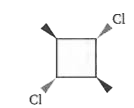Which of the following compound posses centre of symmetry?




The correct Answer is:B
To determine which of the given compounds possesses a center of symmetry, we need to understand the concept of a center of symmetry (also known as an inversion center). A molecule has a center of symmetry if for every atom at position (x, y, z), there is an equivalent atom at position (-x, -y, -z). This means that the molecule can be reflected through a central point, and the parts of the molecule will match up perfectly.
1. Understand the Definition:
- A center of symmetry exists in a molecule if for every atom in the molecule, there is an equivalent atom located at an equal distance from the center but in the opposite direction.
2. Analyze Each Compound:
- We need to examine the structures of the compounds A, B, C, and D to see if they meet the criteria for having a center of symmetry.
3. Examine Compound B:
- The structure of compound B is given as Nc=O (carbonyl), H, C≡N (nitrile), CH3, H, and CO.
- When we analyze this structure, we can see that there are equivalent groups present. For example, the presence of two hydrogen atoms and two CH3 groups indicates symmetry.
4. Reflection Through the Center:
- If we take the center of compound B as the point of reflection, we can see that each group can be reflected back through this point at equal distances but in opposite directions.
5. Conclusion:
- Since compound B has equivalent groups and can be reflected through a central point, it possesses a center of symmetry.
6. Final Answer:
- Therefore, the compound that possesses a center of symmetry is Option B.
- A center of symmetry exists in a molecule if for every atom in the molecule, there is an equivalent atom located at an equal distance from the center but in the opposite direction.
- We need to examine the structures of the compounds A, B, C, and D to see if they meet the criteria for having a center of symmetry.
- The structure of compound B is given as Nc=O (carbonyl), H, C≡N (nitrile), CH3, H, and CO.
- When we analyze this structure, we can see that there are equivalent groups present. For example, the presence of two hydrogen atoms and two CH3 groups indicates symmetry.
- If we take the center of compound B as the point of reflection, we can see that each group can be reflected back through this point at equal distances but in opposite directions.
- Since compound B has equivalent groups and can be reflected through a central point, it possesses a center of symmetry.
- Therefore, the compound that possesses a center of symmetry is Option B.
Topper's Solved these Questions
- STEREOISOMERISMBOOK - RESONANCE ENGLISHCHAPTER - STEREOISOMERISMEXERCISE - EXERCISE (PART II SECTION (F))
6 Videos
- STEREOISOMERISMBOOK - RESONANCE ENGLISHCHAPTER - STEREOISOMERISMEXERCISE - EXERCISE (PART II SECTION (G))
7 Videos
- STEREOISOMERISMBOOK - RESONANCE ENGLISHCHAPTER - STEREOISOMERISMEXERCISE - EXERCISE (PART II SECTION (D))
4 Videos
- SOLUTIONSBOOK - RESONANCE ENGLISHCHAPTER - SOLUTIONSEXERCISE - Advabced Level Problems (PART-2)
35 Videos
- STRUCTURAL IDENTIFICATIONBOOK - RESONANCE ENGLISHCHAPTER - STRUCTURAL IDENTIFICATIONEXERCISE - Advanced level Problems (Part-III)
12 Videos
Similar Questions
Knowledge Check
In which of the following compound, possess plane of symmetry as well as centre of symmetry?
A B
B C
C D
D
Which of the following compound has plane of symmetry ?
R=−CH∣CH3−CH S=−CH∣Br−ClA B
B C
C DNone of these
DNone of theseWhich of the following compounds have the plane of symmetry?
A B
B C
C D
D
Which of the followinG compounds has a 3-centre two electron bond ?
View SolutionIn which of the following compound, centre atom forms six or more than six hybrid orbitals ?
View SolutionWhich of following compound has center of symmetry?
View SolutionA line which bisects a compound in two equal parts and both parts appear to be the mirror image of each other, such kind of symmetry is known as plane of symmetry.
Any molecule that has a internal mirror plane of symmetry cannot be chiral, even though it may contain asymmetric carbon atoms.

Which of the following compounds does not contain plane of symmetry?
View SolutionWhich of the following compounds do not have the plane of symmetry?
View Solution
